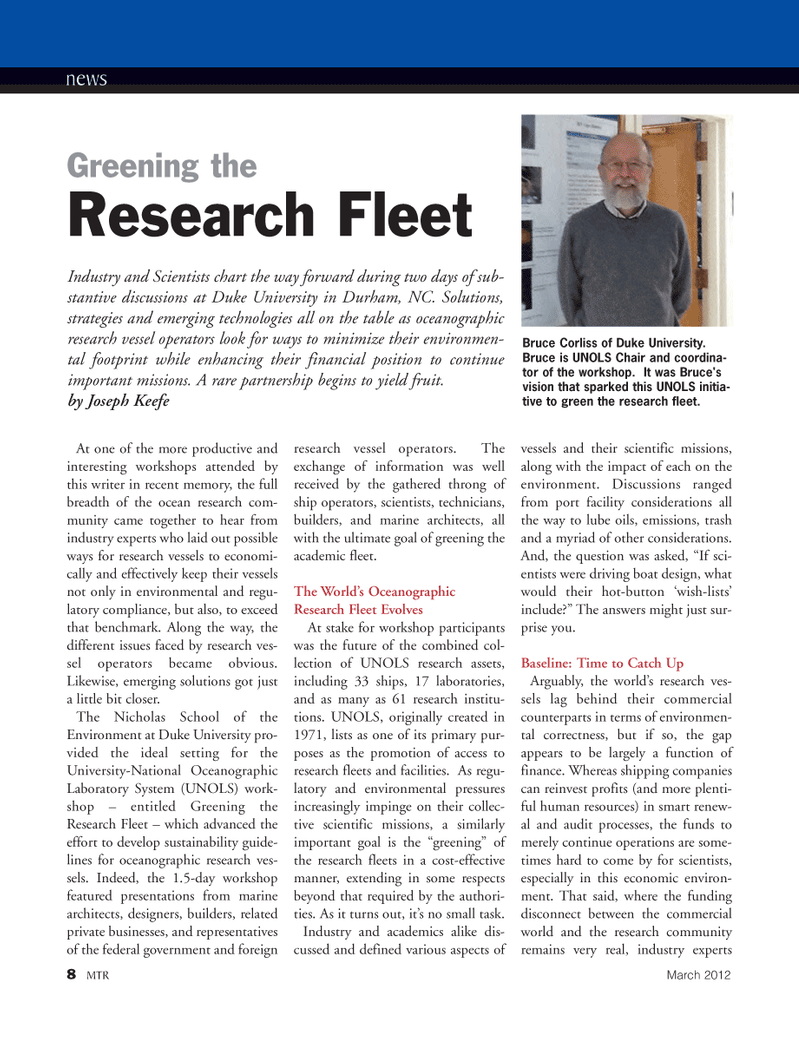
Page 8: of Marine Technology Magazine (March 2012)
Subsea Vehicle Report – Unmanned Underwater Systems
Read this page in Pdf, Flash or Html5 edition of March 2012 Marine Technology Magazine
news At one of the more productive and interesting workshops attended by this writer in recent memory, the full breadth of the ocean research com- munity came together to hear from industry experts who laid out possible ways for research vessels to economi- cally and effectively keep their vessels not only in environmental and regu- latory compliance, but also, to exceed that benchmark. Along the way, the different issues faced by research ves- sel operators became obvious. Likewise, emerging solutions got just a little bit closer. The Nicholas School of the Environment at Duke University pro- vided the ideal setting for theUniversity-National Oceanographic Laboratory System (UNOLS) work- shop ? entitled Greening the Research Fleet ? which advanced the effort to develop sustainability guide- lines for oceanographic research ves- sels. Indeed, the 1.5-day workshop featured presentations from marine architects, designers, builders, related private businesses, and representatives of the federal government and foreign research vessel operators. The exchange of information was well received by the gathered throng of ship operators, scientists, technicians,builders, and marine architects, all with the ultimate goal of greening the academic fleet.The World?s Oceanographic Research Fleet Evolves At stake for workshop participants was the future of the combined col-lection of UNOLS research assets, including 33 ships, 17 laboratories,and as many as 61 research institu- tions. UNOLS, originally created in 1971, lists as one of its primary pur- poses as the promotion of access to research fleets and facilities. As regu- latory and environmental pressures increasingly impinge on their collec- tive scientific missions, a similarly important goal is the ?greening? of the research fleets in a cost-effective manner, extending in some respects beyond that required by the authori- ties. As it turns out, it?s no small task. Industry and academics alike dis- cussed and defined various aspects of vessels and their scientific missions, along with the impact of each on theenvironment. Discussions ranged from port facility considerations all the way to lube oils, emissions, trashand a myriad of other considerations.And, the question was asked, ?If sci- entists were driving boat design, what would their hot-button ?wish-lists? include?? The answers might just sur- prise you. Baseline: Time to Catch Up Arguably, the world?s research ves- sels lag behind their commercialcounterparts in terms of environmen- tal correctness, but if so, the gap appears to be largely a function offinance. Whereas shipping companies can reinvest profits (and more plenti- ful human resources) in smart renew- al and audit processes, the funds to merely continue operations are some- times hard to come by for scientists, especially in this economic environ- ment. That said, where the funding disconnect between the commercial world and the research community remains very real, industry experts 8MTRMarch 2012 Greening the Research Fleet Bruce Corliss of Duke University. Bruce is UNOLS Chair and coordina- tor of the workshop. It was Bruce'svision that sparked this UNOLS initia-tive to green the research fleet. Industry and Scientists chart the way forward during two days of sub- stantive discussions at Duke University in Durham, NC. Solutions, strategies and emerging technologies all on the table as oceanographic research vessel operators look for ways to minimize their environmen- tal footprint while enhancing their financial position to continueimportant missions. A rare partnership begins to yield fruit. by Joseph Keefe MTR#2 (1-17):MTR Layouts 2/21/2012 9:49 AM Page 8

 7
7

 9
9
